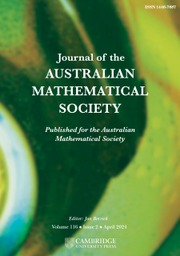No CrossRef data available.
Article contents
ON THE PRODUCT OF ELEMENTS WITH PRESCRIBED TRACE
Published online by Cambridge University Press: 14 May 2020
Abstract
This paper deals with the following problem. Given a finite extension of fields  $\mathbb{L}/\mathbb{K}$ and denoting the trace map from
$\mathbb{L}/\mathbb{K}$ and denoting the trace map from  $\mathbb{L}$ to
$\mathbb{L}$ to  $\mathbb{K}$ by
$\mathbb{K}$ by  $\text{Tr}$, for which elements
$\text{Tr}$, for which elements  $z$ in
$z$ in  $\mathbb{L}$, and
$\mathbb{L}$, and  $a$,
$a$,  $b$ in
$b$ in  $\mathbb{K}$, is it possible to write
$\mathbb{K}$, is it possible to write  $z$ as a product
$z$ as a product  $xy$, where
$xy$, where  $x,y\in \mathbb{L}$ with
$x,y\in \mathbb{L}$ with  $\text{Tr}(x)=a,\text{Tr}(y)=b$? We solve most of these problems for finite fields, with a complete solution when the degree of the extension is at least 5. We also have results for arbitrary fields and extensions of degrees 2, 3 or 4. We then apply our results to the study of perfect nonlinear functions, semifields, irreducible polynomials with prescribed coefficients, and a problem from finite geometry concerning the existence of certain disjoint linear sets.
$\text{Tr}(x)=a,\text{Tr}(y)=b$? We solve most of these problems for finite fields, with a complete solution when the degree of the extension is at least 5. We also have results for arbitrary fields and extensions of degrees 2, 3 or 4. We then apply our results to the study of perfect nonlinear functions, semifields, irreducible polynomials with prescribed coefficients, and a problem from finite geometry concerning the existence of certain disjoint linear sets.
MSC classification
Information
- Type
- Research Article
- Information
- Copyright
- © 2020 Australian Mathematical Publishing Association Inc.
Footnotes
Communicated by M. Coons


